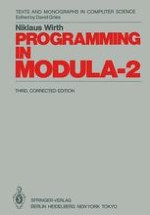1985 | OriginalPaper | Chapter
Representation of Modula programs
Author : Professor Dr. Niklaus Wirth
Published in: Programming in Modula-2
Publisher: Springer Berlin Heidelberg
Included in: Professional Book Archive
Activate our intelligent search to find suitable subject content or patents.
Select sections of text to find matching patents with Artificial Intelligence. powered by
Select sections of text to find additional relevant content using AI-assisted search. powered by
The preceding chapter has introduced a formalism, by which the structures of well-formed programs will subsequently be defined. It defines, however, merely the way in which programs are composed as sequences of symbols, in contrast to sequences of characters. This “shortcoming” is quite intentional: the representation of symbols (and thereby programs) in terms of characters is considered too much dependent on individual implementations for the general level of abstraction appropriate for a language definition. The creation of an intermediate level of representation by symbol sequences provides a useful decoupling between language and ultimate program representation. The latter depends on the available character set As a consequence, we need to postulate a set of rules governing the representation of symbols as character sequences. The symbols of the Modula vocabulary are divided into the following classes: identifiers, numbers, strings, operators and delimiters, and comments.
